How to make an easy okonomiyaki recipe (Japanese pancake)
Okonomiyaki or a savory Japanese pancake. You might have heard if before but here I am giving you an easy version of the recipe to make at home. It’s sometimes also called a Japanese pizza.
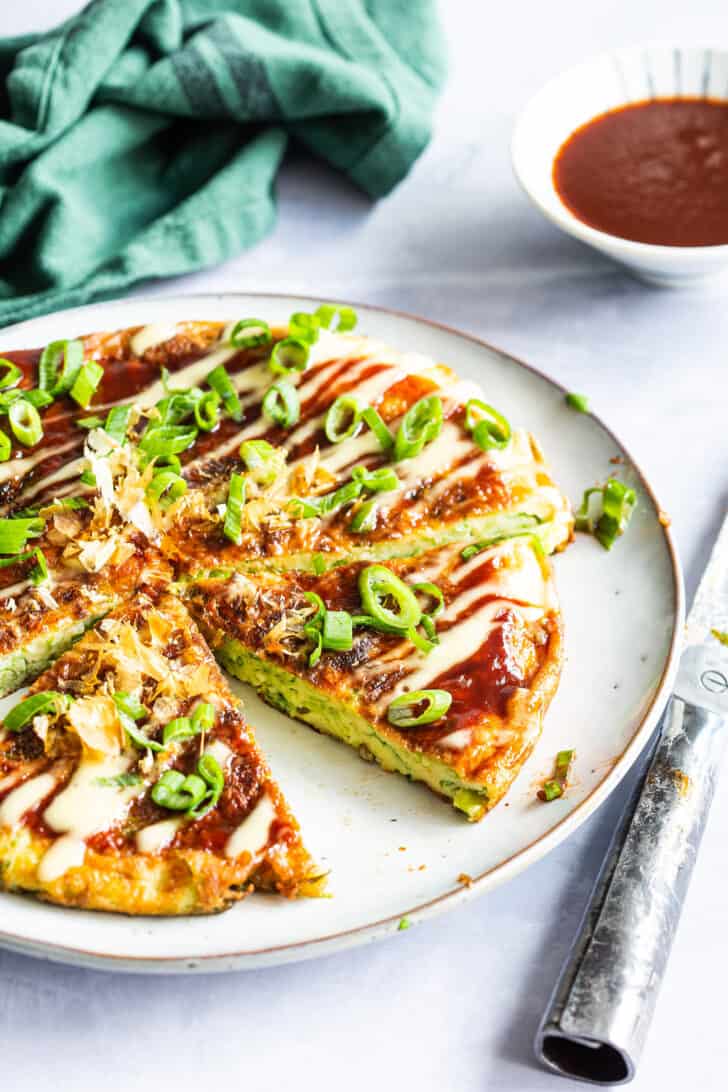
Okonomiyaki recipe
I had seen it a few times on TV during a program about Japan. And I was curious to know exactly what okonomiyaki was. So it was time to start making it myself.
Table of Contents
It’s a household dish in Japan, and you can even get okonomiyaki in a special restaurant. But since going to Japan to taste a traditional okonomiyaki might be something that’s not so easy to do I’m sharing my version here.
The name okonomiyaki is coming from the word okonomi which means ‘as you like’ which I think means you can put anything you like on or in it. 🙂 But that’s just my interpretation.
How to make okonomiyaki
First of all, there are many variations on this basic recipe, and of course you can change it to suit your own tastes. There are some original ingredients that are not readily available here, but I mention them anyway in case you have a well-equipped toko nearby. I have based my recipe on that of a Japanese girl living in America. But first let me give you the traditional ingredients for making this okonomiyaki recipe. You might find some of these in Japanese grocery stores or Asian grocery stores. I have not used most of these but the end result was still totally delicious.
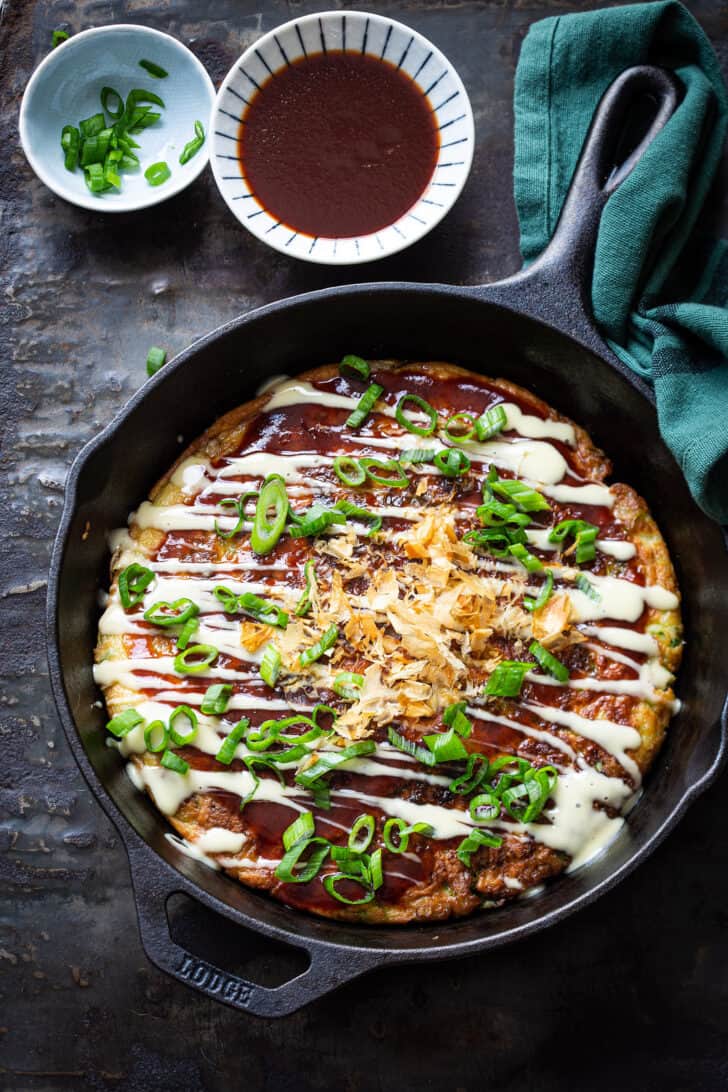
Nagaimo or Yamaimo
This ingredient gives the pancake its lightness and is a type of Japanese yam. Nagaimo seems to be the collective name for this root. For an original okonomiyaki, this root is grated. The characteristic of the root is that it produces a lot of slime. Not very attractive, but this is what gives the Japanese pancake its special texture.
If you cannot find this particular yam, you can buy an okonomiyaki mix (which already contains the carrot) or substitute it with a potato. This will not have the same effect and the pancake will be less airy. A little more baking powder will help. Another solution is to use silken tofu or beaten egg whites.
Tempura bits
Another ingredient that should be in the batter is tempura bits, or the crunchy bits left over from making tempura. You can make these yourself by putting a few drops of batter in the fryer and then stirring them back into the batter. A bit messy though. Some people online recommend substituting crunchy dried shrimp. Which I totally hate so I have not added those on top of the pancake.
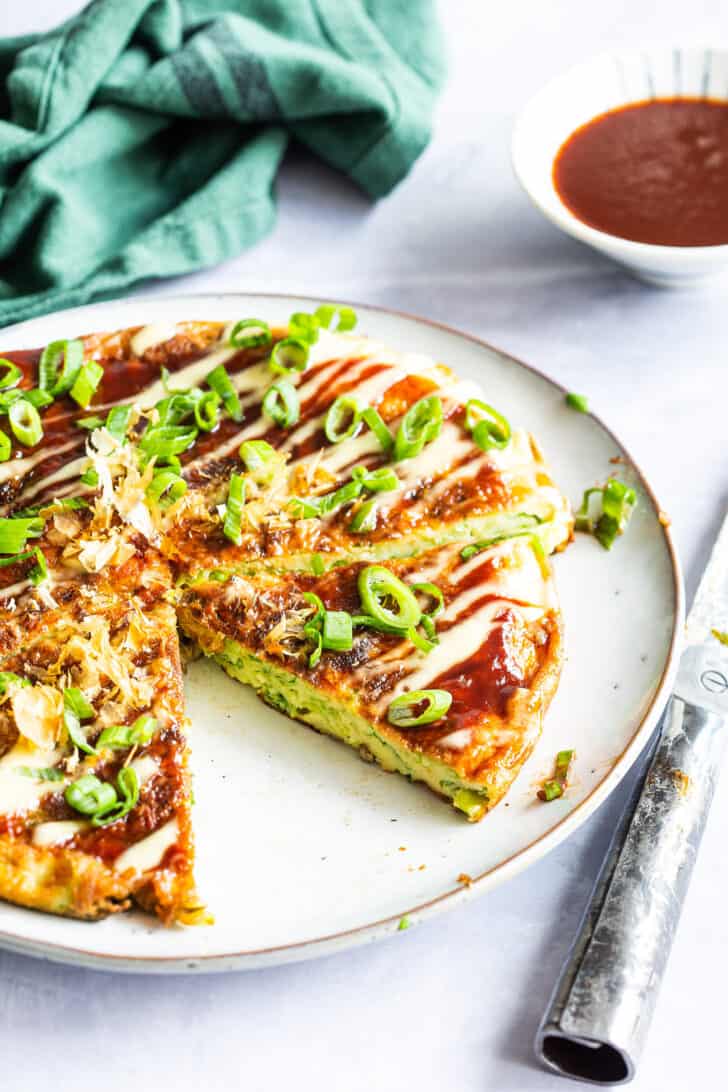
Katsuobushi or bonito flakes
These are actually shaved dried (fermented and smoked) tuna and are fairly easy to find at the Asian grocery store or a well-stocked fish monger. If you don’t like the fishy taste, you can leave it out. It is quite expensive, so not essential.
Kewpie mayonnaise
One of the most distinctive things about okonomiyaki is the okonomiyaki sauce that goes on top. Without it, it is not a true Japanese pancake. Kewpie mayonnaise is part of it. Again, you can easily find this in the toko and even in well-stocked supermarkets. I couldn’t find it, so I bought Japanese mayonnaise in the toko. Tasted good.
Aonori (dried green seaweed).
This bright green seaweed comes in a jar and is used to sprinkle over pancakes. If you don’t have aonori, you can use pieces of nori or leave it out if you don’t like it.
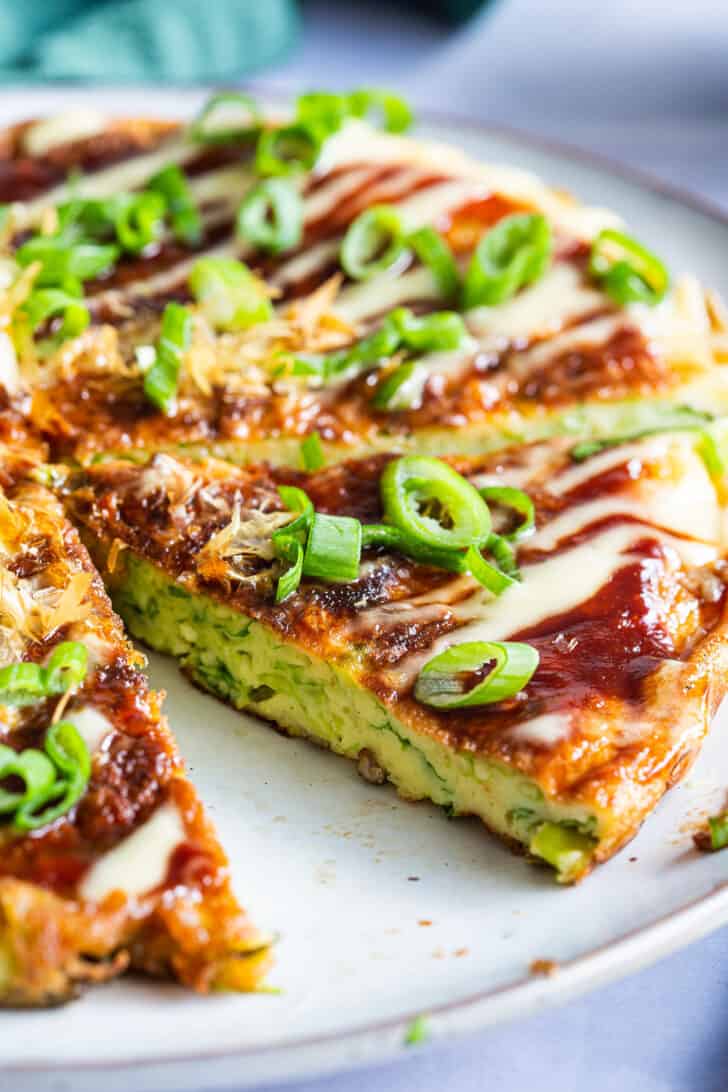
Making okonomiyaki
Ok… Then we move on to making the okonomiyaki. You start by making the okonomiyaki batter. Mix the flour, baking powder, sugar and sea salt together. Grate the potato and add it to the dough. Now pour in the broth and let it refridgerate for at least an hour.
You can make the okonomi sauce in the mean time by just mixing the ingredients. Now chop the Chinese cabbage as thinly as possible and make sure you remove any excess moisture. Too much moisture will create a batter that is too thin.
Adding the cabbage
Once the hour has passed take the batter out of the fridge and add the cabbage. Stir it well. It might look like a lot of cabbage but it will work out in the end. Heat a large nonstick skillet on medium heat to high heat and add plenty of oil and butter. When hot you add the batter and add the shittake slices on top. Now turn the heat down a bit and place a lid on top. Let it cook for about 3-5 minutes. Check to see if the bottom is golden brown. If that is the case gently flip the pancake. I use a second plate for that to make it easier. I slide the okonomiyaki onto the plate and using a second plate flip it over and slide it back into the pan. You can also use the pan to do that but since the pan is hot that can be a bit tricky.
Golden brown
Once the second side is also golden brown slide the Japanese pancakes onto plates and top with the sauce. I first spread the dark sauce on, then I add the kewpie mayonnaise and the toppings. In this case I used green onion, sliced and bonito flakes. You can also use seaweed flakes or sesame seeds. I like spring onions, but feel free to leave them out. You can serve this Japanese cabbage pancake as breakfast or dinner. I’m more inclined to eat this for dinner as it is pretty filling but if you like cabbage pancakes for breakfast go for it.
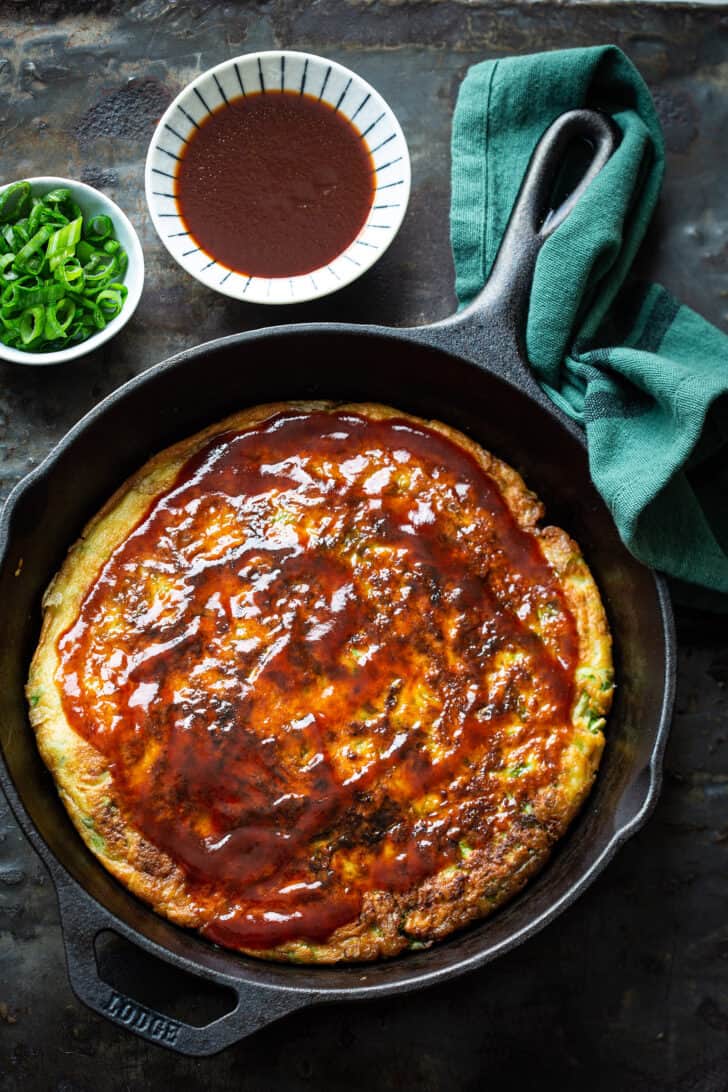
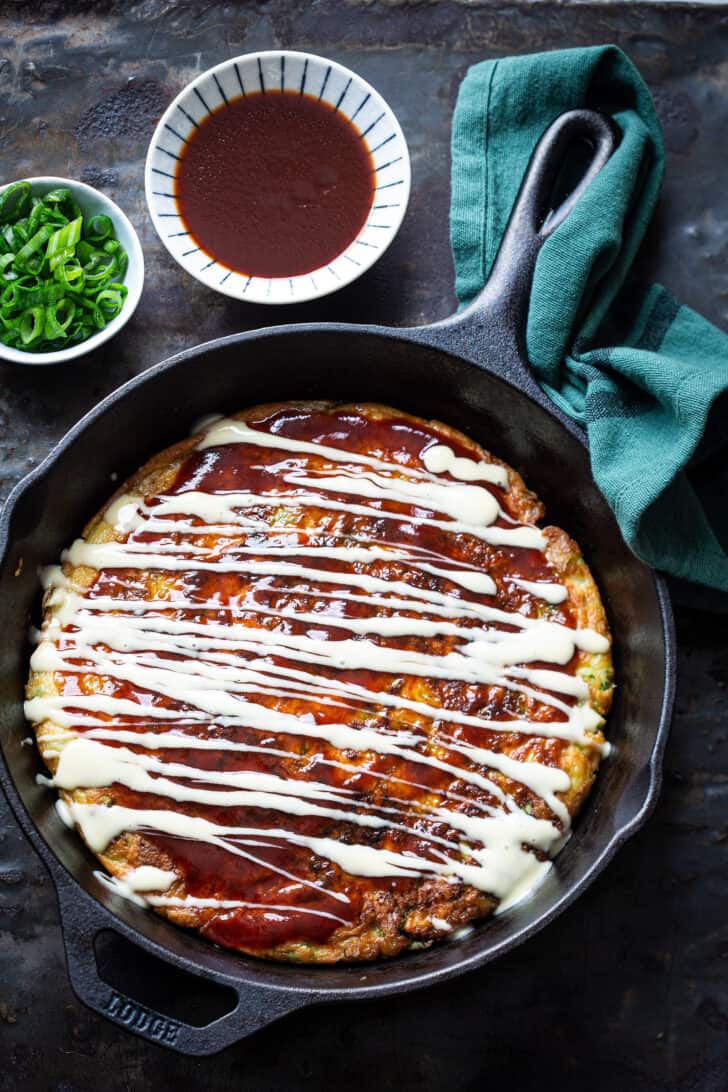
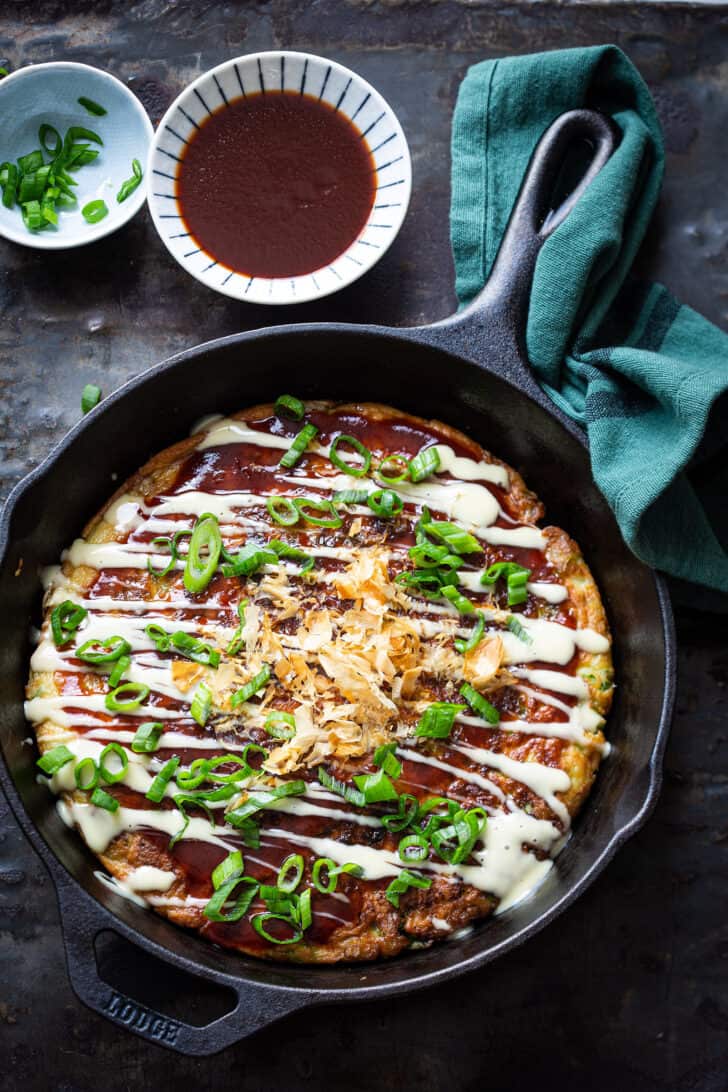
Different styles of okonomiyaki
There are different styles of okonomiyaki and apparently there is a hiroshima-style okonomiyaki that’s pretty famous. Since the name says ‘ put anything on it’ you can definitely go wild here. I love adding some crispy pork belly slices to it as well and I sometimes use simple bbq sauce instead of making the okonomiyaki sauce. I also made a paleo version of this Japanese savory pancake which I will be sharing next time.
Do you think making okonomiyaki is too much work? Then you can just make a nice vegetable omelette or my Asian shrimp omelette.

Okonomiyaki recipe
Ingredients
- 120 g flour
- ¼ teaspoon sea salt
- ¼ tsp sugar
- ¼ tsp baking powder
- 1 medium boiled potato
- 180 ml stock
- 1 Chinese cabbage finely shredded
- 100 gr shiitake
- 4 eggs
Okonomiyaki sauce
- 1 ½ tbsp sugar
- 2 Tbsp oyster sauce
- 4 Tbsp hot ketchup
- 3 ½ Tbsp Worcestershire sauce
Garnishes
- 3 Tbsp okonomiyaki sauce
- Japanese mayonnaise Kewpie or similar
- Katsuobushi dried bonito flakes
- 1 spring onion ring
How to make an okonomiyaki
- Start by making the batter. Mix the flour, baking powder, sugar and sea salt together.
- Grate the potato and add it to the dough.
- Pour in the broth and mix well. Refrigerate for at least 1 hour.
- Meanwhile, make the sauce by mixing the sauce ingredients.
- Meanwhile, chop the Chinese cabbage very finely. Make sure there is no moisture in the cabbage, as it will make the dough thinner.
- Slice the shiitake.
- After an hour, add the four eggs to the batter and whisk. Add the finely chopped cabbage and stir well.
- Heat a frying pan over high heat with plenty of oil and butter. When hot, pour the batter into the pan and lower the heat slightly. Spread the shiitake slices on top. Cover and cook for five minutes.
- After 5 minutes, check to see if the bottom is nicely browned. If so, flip the pancake. Is it difficult or not daring? Then slide it onto a plate, place a second plate on top, flip it and slide it back into the pan.
- Bake the second side with the lid on the pan for 5 minutes, then finish baking for another 2 minutes without the lid.
- Transfer the pancakes to a plate and spread a few tablespoons of the okonomiyaki sauce on top. Drizzle the mayonnaise on top in the characteristic way (see photo) and finish with the bonito flakes and scallions.
- Serve hot.
Nutrition Information per portion
Disclaimer
The nutritional values above are calculated per portion. The details are based on standard nutritional tables and do not constitute a professional nutritional advice.
